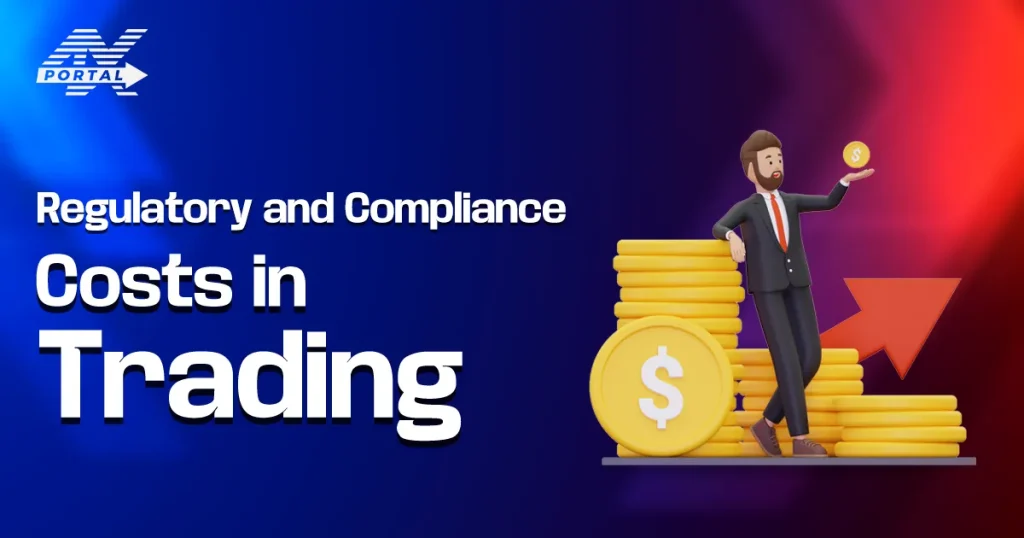The financial markets are heavily regulated to ensure fairness, transparency, and investor protection. These regulations come with associated trading compliance costs, which impact brokers, financial institutions, and even individual traders. Regulatory costs include licensing fees, reporting requirements, and risk management expenses that trading platforms and financial firms must bear to stay compliant with trading regulations. Most of these costs are passed on to the traders through compliance fees, transaction charges, or higher spreads. The better an investor understands how these costs affect trading, the better decisions they can make and which platform to use.
Understanding Trading Compliance & Regulatory Costs
Trading compliance costs refer to the money that a broker or financial institute spends on adhering to all regulatory rules of trading formulated by the bodies that regulate trading. This essentially pertains to all other costs generated by steps toward preventing fraud, fair-market practices, and investors against fraudulent activities. Then there are legal costs, auditing costs, cybersecurity investments, and expenses to maintain compliance teams.
The regulations may be established by the authorities themselves, such as the Securities and Exchange Commission (SEC) in the U.S., the Financial Conduct Authority (FCA) in the UK, and the European Securities and Markets Authority (ESMA) in the EU. Failure to comply can be very costly because of fines or legal action taken against them. To pay for these compliance costs, brokers either charge compliance fees or integrate those costs into the overall fee.
Impact of Regulatory Costs on Brokers
Regulatory costs may have a direct impact on the operational costs of brokers and trading platforms. Such costs are due to licensing, mandatory reporting, and the development of measures to prevent financial crimes such as money laundering and insider trading. Know Your Customer (KYC) and Anti-Money Laundering (AML) regulations force brokers to carry out identity verification and monitor transactions for suspicious activities, which contribute to their operational costs.
Many brokers rebalance their commission structures to reflect these costs. 4x Portal increase their trading commissions; others charge maintenance fees on their accounts or enlarge the spreads used on forex and CFD products. Discount commission-free brokers pass the regulatory burden along to the trader through obscure charges such as withdrawal fees, premium account demands, or interest on margin requirements.
Compliance Fees Passed along to Traders
Although the full cost of compliance with trading laws is borne by the brokers, this expense often falls on traders through compliance fees. Many sites have a low regulatory transaction charge for each transaction in a certain type of trade, such as stock and option trading. In the U.S., for example, the fees to the SEC transaction fee, which are often part of any equity and option trades, plus FINRA activity trading fees must be paid.
Compliancy-based expenses are, for instance maintained through inactivity fees by brokers for accounts not being active after long periods of time. Typically, these cost between $10 and $50 annually depending on the platform, although regulatory expenses maintain market integrity, they further add to costs of trading, particularly for small investors.
Cost Management through Regulations on Trading
Regulations on trading aim to safeguard investors and ensure the stability of markets, but at the same time, they also increase the cost of operations for brokers. More stringent regulations come into place when there is a financial crisis or a major shock in the market. For instance, the Dodd-Frank Act in the United States and the MiFID II regulations in Europe have added more stringent reporting requirements, and thus, more costs for the brokers in reporting systems and risk management.
The regulated online brokers should offer transparent price, safety of client funds, and a capital reserve to mitigate risks of losses in finance. These protective measures ensure greater security but drive regulatory costs to increase, which increases traders’ fees. The unregulated or offshore brokers are characterized by fewer charges but higher risks due to investors’ lack of protection.
Variety of Compliance Costs for Diverse Market Participants
Different market participants experience trading compliance costs in different ways. Retail traders may incur small compliance fees per transaction, but institutional investors and hedge funds often incur large regulatory expenses. Large trading firms must allocate large budgets to legal teams, compliance officers, and cybersecurity systems to meet the changing regulations of trading.
For HFT firms, regulatory costs are even higher as the firms must use real-time transaction reporting and risk management systems. In algorithmic trading, most regulators impose fees on firms to prevent manipulation of the market and extreme volatility. Thus, regulations force trading platforms and institutional investors to periodically modify their compliance strategies, further raising costs.
Neutralizing Compliance Fees Costs
Traders can take measures to reduce the trading compliance costs’ impact on their investments. They can choose a broker with a transparent fee structure and know about regulatory fees before executing trades to avoid any unexpected costs. Some brokers absorb regulatory charges, while others explicitly list them in their fee breakdowns.
Moreover, traders can save on compliance costs by avoiding inactivity fees, using cheap withdrawal methods, and choosing regulated brokers that charge less. While offshore brokers might offer lower fees, they often have weak regulatory oversight, increasing the risk of fraud or fund mismanagement. Balancing cost savings with regulatory protection is essential for long-term trading success.
Conclusion
Trading compliance costs are very important in ensuring that financial markets are fair and transparent, but they also contribute to higher trading expenses for both brokers and investors. Regulatory costs such as licensing, reporting, and risk management are necessary to ensure market integrity but often lead to increased compliance fees passed down to traders. Educating oneself on how rules in trading affect pricing models for brokers is one way to make investors knowledgeable decision makers and ensure that the right options are availed to them in terms of balance between security and affordability. Such individuals will, therefore, achieve the best compliance through regulations while sticking to an efficient trading cost model.










